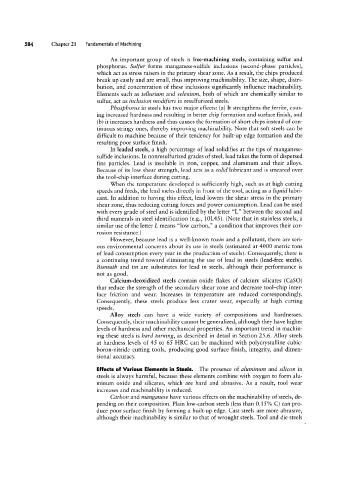Page 603 - 04. Subyek Engineering Materials - Manufacturing, Engineering and Technology SI 6th Edition - Serope Kalpakjian, Stephen Schmid (2009)
P. 603
Chapter 21 Fundamentals of Machining
An important group of steels is free-machining steels, containing sulfur and
phosphorus. Sulfur forms manganese-sulfide inclusions (second-phase particles),
which act as stress raisers in the primary shear zone. As a result, the chips produced
break up easily and are small, thus improving machinability. The size, shape, distri-
bution, and concentration of these inclusions significantly influence machinability.
Elements such as tellurium and selenium, both of which are chemically similar to
sulfur, act as inclusion modifiers in resulfurized steels.
Phosphorus in steels has two major effects: (a) It strengthens the ferrite, caus-
ing increased hardness and resulting in better chip formation and surface finish, and
(b) it increases hardness and thus causes the formation of short chips instead of con-
tinuous stringy ones, thereby improving machinability. Note that soft steels can be
difficult to machine because of their tendency for built-up edge formation and the
resulting poor surface finish.
In leaded steels, a high percentage of lead solidifies at the tips of manganese-
sulfide inclusions. In nonresulfurized grades of steel, lead takes the form of dispersed
fine particles. Lead is insoluble in iron, copper, and aluminum and their alloys.
Because of its low shear strength, lead acts as a solid lubricant and is smeared over
the tool-chip interface during cutting.
When the temperature developed is sufficiently high, such as at high cutting
speeds and feeds, the lead melts directly in front of the tool, acting as a liquid lubri-
cant. In addition to having this effect, lead lowers the shear stress in the primary
shear zone, thus reducing cutting forces and power consumption. Lead can be used
with every grade of steel and is identified by the letter “L” between the second and
third numerals in steel identification (e.g., 10L45). (Note that in stainless steels, a
similar use of the letter L means “low carbon,” a condition that improves their cor-
rosion resistance.)
However, because lead is a well-known toxin and a pollutant, there are seri-
ous environmental concerns about its use in steels (estimated at 4000 metric tons
of lead consumption every year in the production of steels). Consequently, there is
a continuing trend toward eliminating the use of lead in steels (lead-free steels).
Bismuth and tin are substitutes for lead in steels, although their performance is
not as good.
Calcium-deoxidized steels contain oxide flakes of calcium silicates (CaSO)
that reduce the strength of the secondary shear zone and decrease tool-chip inter-
face friction and wear. Increases in temperature are reduced correspondingly.
Consequently, these steels produce less crater wear, especially at high cutting
speeds.
Alloy steels can have a wide variety of compositions and hardnesses.
Consequently, their machinability cannot be generalized, although they have higher
levels of hardness and other mechanical properties. An important trend in machin-
ing these steels is hard turning, as described in detail in Section 25.6. Alloy steels
at hardness levels of 45 to 65 HRC can be machined with polycrystalline cubic-
boron-nitride cutting tools, producing good surface finish, integrity, and dimen-
sional accuracy.
Effects of Various Elements in Steels. The presence of aluminum and silicon in
steels is always harmful, because these elements combine with oxygen to form alu-
minum oxide and silicates, which are hard and abrasive. As a result, tool wear
increases and machinability is reduced.
Carhon and manganese have various effects on the machinability of steels, de-
pending on their composition. Plain low-carbon steels (less than 0.15% C) can pro-
duce poor surface finish by forming a built-up edge. Cast steels are more abrasive,
although their machinability is similar to that of wrought steels. Tool and die steels

